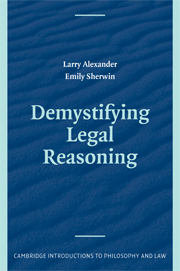Book contents
- Frontmatter
- Contents
- Introduction
- PART ONE Law and Its Function
- PART TWO Common-Law Reasoning: Deciding Cases When Prior Judicial Decisions Determine the Law
- II Ordinary Reason Applied to Law: Natural Reasoning and Deduction from Rules
- III The Mystification of Common-Law Reasoning
- IV Common-Law Practice
- PART THREE Reasoning from Canonical Legal Texts
- Epilogue: All or Nothing
- Selected Bibliography
- Index
- References
II - Ordinary Reason Applied to Law: Natural Reasoning and Deduction from Rules
Published online by Cambridge University Press: 05 June 2012
- Frontmatter
- Contents
- Introduction
- PART ONE Law and Its Function
- PART TWO Common-Law Reasoning: Deciding Cases When Prior Judicial Decisions Determine the Law
- II Ordinary Reason Applied to Law: Natural Reasoning and Deduction from Rules
- III The Mystification of Common-Law Reasoning
- IV Common-Law Practice
- PART THREE Reasoning from Canonical Legal Texts
- Epilogue: All or Nothing
- Selected Bibliography
- Index
- References
Summary
In our view, there are two plausible models of common-law reasoning, and only two. The first is the “natural” model, in which courts resolve disputes by deciding what outcome is best, all things considered. In the courts' balance of reasons for decision, prior judicial decisions are entitled to exactly the weight they naturally command. The second model of common-law reasoning is the “rule” model, in which courts treat rules announced by prior courts as serious rules of decision, but then revert to natural decision making when rules provide no answers.
The difference between these two models of common-law reasoning is that the natural model treats judicial decisions as facts about the world, whereas the rule model treats them as sources of law. In the next chapter, we explain why, contrary to many popular views of common-law decision making, we believe that there are no other intelligible ways to reason from precedent.
The Natural Model of Common-Law Reasoning
The most obvious tools for courts to use in addressing controversies are moral and empirical reasoning. We assume that moral reasoning follows the Rawlsian method of wide reflective equilibrium: the reasoner makes an initial judgment about how a particular case should be resolved, formulates a tentative moral principle to support his or her initial judgment, and then tests the principle by picturing other actual and hypothetical examples of its application. If the principle yields results the reasoner judges to be wrong in test cases, the reasoner must refine the analysis.
- Type
- Chapter
- Information
- Demystifying Legal Reasoning , pp. 31 - 63Publisher: Cambridge University PressPrint publication year: 2008

